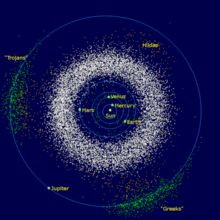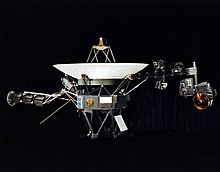Brahaspati
 | |||||||||||||||||||||||
| Orbital characteristics[1][2] Epoch J2000 | |||||||||||||||||||||||
|---|---|---|---|---|---|---|---|---|---|---|---|---|---|---|---|---|---|---|---|---|---|---|---|
| Aphelion | 816,520,800 km (5.458104 AU) | ||||||||||||||||||||||
| Perihelion | 740,573,600 km (4.950429 AU) | ||||||||||||||||||||||
| Semi-major axis | 778,547,200 km (5.204267 AU) | ||||||||||||||||||||||
| Eccentricity | 0.048775 | ||||||||||||||||||||||
| Orbital period | 4,331.572 days 11.85920 yr 10,475.8 Jupiter solar days[3] | ||||||||||||||||||||||
| Synodic period | 398.88 days[4] | ||||||||||||||||||||||
| Average orbital speed | 13.07 km/s[4] | ||||||||||||||||||||||
| Mean anomaly | 18.818° | ||||||||||||||||||||||
| Inclination | 1.305° to Ecliptic 6.09° to Sun's equator 0.32° to Invariable plane[5] | ||||||||||||||||||||||
| Longitude of ascending node | 100.492° | ||||||||||||||||||||||
| Argument of perihelion | 275.066° | ||||||||||||||||||||||
| Satellites | 63 | ||||||||||||||||||||||
| Physical characteristics | |||||||||||||||||||||||
| Mean radius | 69,911 ± 6 km[6][7] | ||||||||||||||||||||||
| Equatorial radius | 71,492 ± 4 km[6][7] 11.209 Earths | ||||||||||||||||||||||
| Polar radius | 66,854 ± 10 km[6][7] 10.517 Earths | ||||||||||||||||||||||
| Flattening | 0.06487 ± 0.00015 | ||||||||||||||||||||||
| Surface area | 6.1419×1010 km2[7][8] 121.9 Earths | ||||||||||||||||||||||
| Volume | 1.4313×1015 km3[4][7] 1321.3 Earths | ||||||||||||||||||||||
| Mass | 1.8986×1027 kg[4] 317.8 Earths 1/1047 Sun[9] | ||||||||||||||||||||||
| Mean density | 1.326 g/cm3[4][7] | ||||||||||||||||||||||
| Equatorial surface gravity | 24.79 m/s2[4][7] 2.528 g | ||||||||||||||||||||||
| Escape velocity | 59.5 km/s[4][7] | ||||||||||||||||||||||
| Sidereal rotation period | 9.925 h[10] (9 h 55 m 30 s) | ||||||||||||||||||||||
| Rotation velocity at equator | 12.6 km/s 45,300 km/h | ||||||||||||||||||||||
| Axial tilt | 3.13°[4] | ||||||||||||||||||||||
| Right ascension of North pole | 268.057° 17 h 52 min 14 s[6] | ||||||||||||||||||||||
| Declination of North pole | 64.496°[6] | ||||||||||||||||||||||
| Albedo | 0.343 (Bond) | ||||||||||||||||||||||
| Surface temperature: 1 bar level 0.1 bar |
| ||||||||||||||||||||||
| Apparent magnitude | -1.6 to -2.94[4] | ||||||||||||||||||||||
| Angular size | 29.8" — 50.1"[4] | ||||||||||||||||||||||
| Adjectives | Jovian | ||||||||||||||||||||||
| Atmosphere[4] | |||||||||||||||||||||||
| Surface pressure | 20–200 kPa[11] (cloud layer) | ||||||||||||||||||||||
| Scale height | 27 km | ||||||||||||||||||||||
| Composition |
| ||||||||||||||||||||||
Brahaspati (pratiik: ![]() , Jupiter), Saur mandal (Solar System) ke sab se barraa grah (planet) hae.[12] aur ii Suraj se duur 5th planet hae. Brahaspati ke ek gas giant planet bola jaawe hae, kaahe ki ii bahut barraa hae aur gas se banaa hae. Duusra giant planet hae Sanigrah (Saturn), Arungrah (Uranus) aur Varungrah (Neptune). Brahaspati ke wajan 1.8986×1027 kg hae jon ki Dunia se 317.8 dafe jaada hae.[8] This is twice the mass of all the other planets in the Solar System put together.[12]
, Jupiter), Saur mandal (Solar System) ke sab se barraa grah (planet) hae.[12] aur ii Suraj se duur 5th planet hae. Brahaspati ke ek gas giant planet bola jaawe hae, kaahe ki ii bahut barraa hae aur gas se banaa hae. Duusra giant planet hae Sanigrah (Saturn), Arungrah (Uranus) aur Varungrah (Neptune). Brahaspati ke wajan 1.8986×1027 kg hae jon ki Dunia se 317.8 dafe jaada hae.[8] This is twice the mass of all the other planets in the Solar System put together.[12]
Brahaspati ke purana Romans log jaanat rahin aur uu logan iske Roman god, Jupiter, (Latin: luppiter) ke naam ke baad rakkhin rahaa.[13][14] Brahaspati, raat ke aasmaan me tiisra sab se brightest object hae, Chandarma aur Venus ke baad me. [15] Brahaspati ke lage kamti se kamti 63 chandarma hae, jisme se 55 5km diameter se chhota hae. Chaar khaar chandarma hae Io, Europa, Ganymede aur Callisto.
Banawat[badlo | source ke badlo]
Brahaspati, Solar System ke sab se barraa planet hae, jiske diameter 142,984 km hae. Ii dunia ke diameter se 11 dafe jaada hae. [12]





Waatawaran[badlo | source ke badlo]
Brahaspati ke surface ke hawaa me 85.8 to 89.8% hydrogen, 8.2 to 12.2% helium, aur 1% duusra gas hae.[4] Planet ke aur bhittar jaao tab bahut garam rahe hae aur pressure etna jada rahe hae ki helium ras ban jaae hae aur planet ke bhitar paani barrse hae.[16] Brahaspati ke gas Saturn ke rakam hae lekin ii Neptune aur Uranus se different har jahaan pe aur kamti hydrogen aur helium gas hae.[17]
Jaada garmi aur pressure ke kaaran scientist logan ii nai batae sake hae ki Brahaspati ke biich me kon chij hae, kaahe ki ii rakam ke pressure dunia me nai mile hae. Iske biich se thorra bahar jaao tab ek mota hydrogen ke ras hae.[12] Ii pressure etna jaada hae ki hydrogen karraa hoe jaawe hae lekin fir se garmii ke kaaran ras ban jaawe hae.
Wajan[badlo | source ke badlo]
Brahaspati solar system ke aur sab planet ke jorr ke dugna garrhuu hae.[12] Because of all the gas near the core, it gives off more heat than it gets from the sun.[18] Brahaspati, Dunia se 11 dafe jaada lamba hae aur 318 dafe jaada garrhu hae. Iske volume, Dunia ke volume se 1,317 dafe jaada hae, iske matlab ii hae ki 1,317 dunia isme fit hoe jaawe sake hae. [19]
References[badlo | source ke badlo]
- ↑ Yeomans, Donald K. (2006-07-13). "HORIZONS System". NASA JPL. Retrieved 2007-08-08. — At the site, go to the "web interface" then select "Ephemeris Type: Elements", "Target Body: Jupiter Barycenter" and "Center: Sun".
- ↑ Orbital elements refer to the barycenter of the Jupiter system, and are the instantaneous osculating values at the precise J2000 epoch. Barycenter quantities are given because, in contrast to the planetary centre, they do not experience appreciable changes on a day-to-day basis from to the motion of the moons.
- ↑ Seligman, Courtney. "Rotation Period and Day Length". Retrieved 2009-08-13.
- ↑ 4.00 4.01 4.02 4.03 4.04 4.05 4.06 4.07 4.08 4.09 4.10 4.11 4.12 4.13 4.14 Cite error: Invalid
<ref>tag; no text was provided for refs namedfact - ↑ "The MeanPlane (Invariable plane) of the Solar System passing through the barycenter". 2009-04-03. Archived from the original on 2009-04-20. Retrieved 2009-04-10. (produced with Solex 10 written by Aldo Vitagliano; see also Invariable plane)
- ↑ 6.0 6.1 6.2 6.3 6.4 Seidelmann, P. Kenneth; Archinal, B. A.; A’Hearn, M. F.; et al. (2007). "Report of the IAU/IAGWorking Group on cartographic coordinates and rotational elements: 2006". Celestial Mechanics and Dynamical Astronomy 90 (3): 155–180. doi:10.1007/s10569-007-9072-y. http://adsabs.harvard.edu/doi/10.1007/s10569-007-9072-y. Retrieved 2007-08-28.
- ↑ 7.0 7.1 7.2 7.3 7.4 7.5 7.6 7.7 Refers to the level of 1 bar atmospheric pressure
- ↑ 8.0 8.1 "Solar System Exploration: Jupiter: Facts & Figures". NASA. 7 May 2008. Cite error: Invalid
<ref>tag; name "nasafact" defined multiple times with different content - ↑ "Astrodynamic Constants". JPL Solar System Dynamics. 2009-02-27. Retrieved 2007-08-08.
- ↑ Seidelmann, P. K.; Abalakin, V. K.; Bursa, M.; Davies, M. E.; de Burgh, C.; Lieske, J. H.; Oberst, J.; Simon, J. L.; Standish, E. M.; Stooke, P.; Thomas, P. C. (2001). "Report of the IAU/IAG Working Group on Cartographic Coordinates and Rotational Elements of the Planets and Satellites: 2000". HNSKY Planetarium Program. Archived from the original on 2018-09-30. Retrieved 2007-02-02.CS1 maint: multiple names: authors list (link)
- ↑ Anonymous (March 1983). "Probe Nephelometer". Galileo Messenger (NASA/JPL) (6). http://www2.jpl.nasa.gov/galileo/messenger/oldmess/2Probe.html. Retrieved 2007-02-12.
- ↑ 12.0 12.1 12.2 12.3 12.4 "Jupiter - A world book". NASA. Archived from the original on 2011-08-10. Retrieved 2009-07-20.
- ↑ "Etymology of Jupiter". Etym Online. Retrieved 2009-07-20.
- ↑ Bunson, Mathew (in English). A Dictionary of the Roman Empire. Oxford University Press. ISBN 9780195102338.
- ↑ "The biggest single object we can see in our galaxy, with the unaided eye". NASA. Archived from the original on 2009-06-05. Retrieved 2009-07-20.
- ↑ "Highlights of the Galileo Probe Mass Spectrometer Investigation". Archived from the original on 2009-04-10. Retrieved 2009-07-20.
- ↑ Ingersoll, A. P.; Hammel, H. B.; Spilker, T. R.; Young, R. E. (2005). "Outer Planets: The Ice Giants" (PDF). Lunar & Planetary Institute. Retrieved 2007-02-01.CS1 maint: multiple names: authors list (link)
- ↑ Elkins-Tanton, Linda T. (2006). Jupiter and Saturn. New York: Chelsea House.
- ↑ Jupiter. NASA. Retrieved on 20 Julai 2009.
Duusra websites[badlo | source ke badlo]
- Jupiter Profile. NASA's Solar System Exploration NASA. Retrieved on 5 Saptambar 2009.
- Jupiter Fact Sheet. NASA. Retrieved on 5 Saptambar 2009.
- Moons of Jupiter articles in Planetary Science Research Discoveries. Planetary Science Research Discoveries. Retrieved on 5 Saptambar 2009.
Saur mandal (Solar System)
| |||||||
|---|---|---|---|---|---|---|---|
| Suraj • Heliosphere |
Grah (Planets) ☾ = Chaand ∅ = rings |
Budhgrah (Mercury) | Sukhgrah (Venus) | Dunia (Earth) ☾ | Mangalgrah (Mars) ☾ | ||
| Brahaspati (Jupiter) ☾ ∅ | Sanigrah (Saturn) ☾ ∅ | Arungrah (Uranus) ☾ ∅ | Varungrah (Neptune) ☾ ∅ | ||||
| Bauna grah (Dwarf planet) |
Ceres | Pluto ☾ | Haumea ☾ | Makemake | |||
| Eris ☾ | |||||||
| Small Solar System bodies |
Chhota tara (Asteroid) (minor planets) |
Groups and families: Vulcanoids · Near-Earth asteroids · Asteroid belt Jupiter Trojans · Centaurs · Neptune Trojans · Asteroid moons · Meteoroids · Pallas · Juno · Vesta · Hygiea · | |||||
| See also the list of asteroids. | |||||||
| Trans- Neptunians |
Kuiper belt – Plutinos: Orcus · Ixion – Cubewanos: Varuna · Quaoar · Huya | ||||||
| Scattered disc: Sedna | |||||||
| Jhaarru | Lists of periodic and non-periodic comets Damocloids · Hills cloud · Oort cloud | ||||||
| See also the list of solar system objects | |||||||

